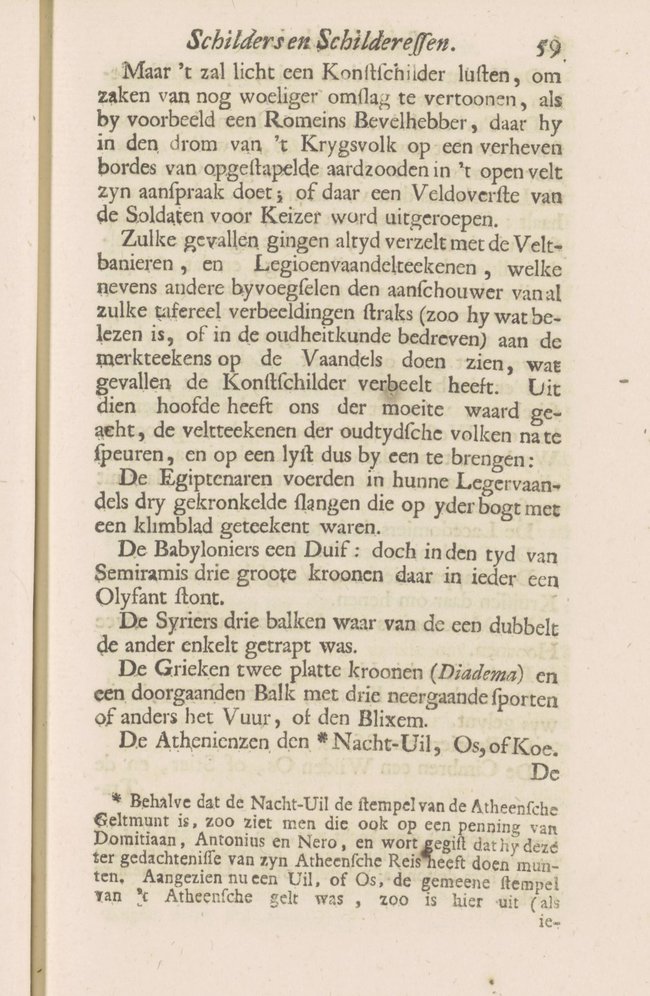Volume 2, page 50-59
Page 50
has assured me that he was from Hamburg by birth and lived in Leeuwarden in Friesland for many years, painted at the court there, including in the service of the prince Henrik Casimir II of Nassau-Dietz (see how greatly information may differ) and died in 1685. The latter version must be taken for the more certain because if Juriaen Jacobsz died in 1664 and the mentioned Hendrik Carré I was born in 1658, he could not have been a student of his.
I was at a loss to assign an appropriate place to ROBERT van den HOECKE until his portrait, painted by Gonzales Coques fell into my hands, as proof that he lived in the latter’s time [1].
His preference fell on the depiction of military marches and battles, with their train, such as canons and army wagons required for battle, but also the misery that war bring with it, and this so small and artful that it is witnessed with amazement that in an unbelievably small format, he was able to paint thousands of figures, each animated and real. He was from Antwerp and the highest supervisor of fortification architecture. His precise contemporary and fellow artist
PIETER MEERT, born in Brussels, was an artful portrait painter. Samples of the praiseworthy art of his brush are now still to be seen in various guild and trade rooms in Brussels.
They testify that there are no worldly treasures, or jewels.
To be found as beautiful as the work of his brushes.
To speak with Cornelis de Bie.
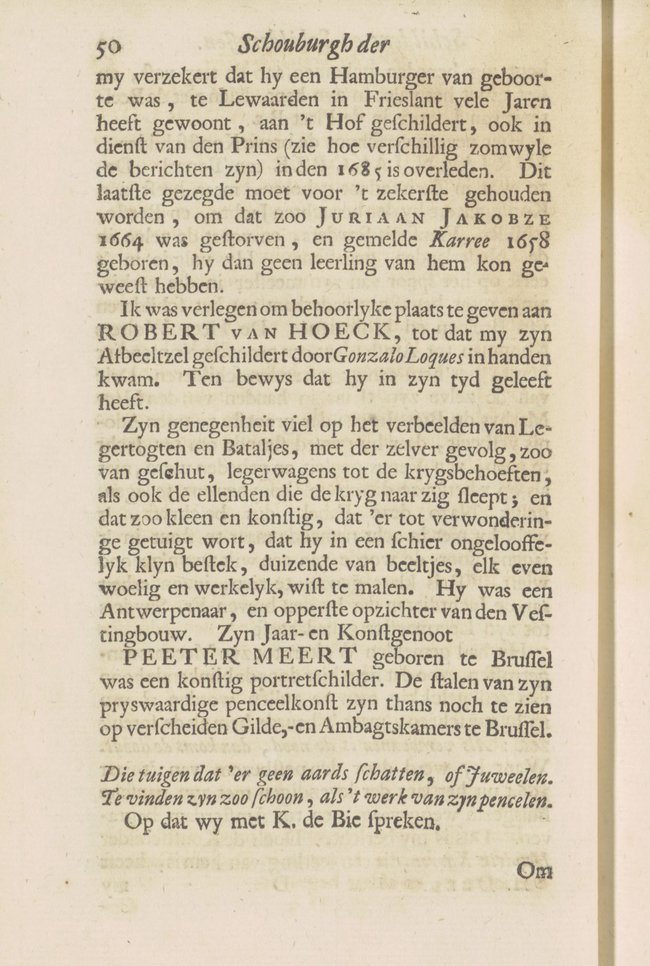

1
Cornelis van Caukercken after Gonzales Coques
Portrait of Robert van den Hoecke (1622-1668), c. 1661
London (England), British Museum, inv./cat.nr. Sheepshanks.7392
Page 51
Around and about this time was born the painter ANTHONIE WATERLOO. Some claim he was born in Amsterdam, but most say it was Utrecht. The art of his brush, beloved by art lovers everywhere, shows that when painting his landscapes he followed nature itself, simply without adding any embellishment. Just as many of his drawings and a good number of his personally etched prints clearly show that they are based on life and drawn around Utrecht. The skies behind his landscapes are bright, the recessions clear, the green of the trees varied according to their distinctive nature, as also the trunks and especially the reflections in the water naturally painted.
The painter Jan Weenix, who still lives, has told me that he knew him particularly well and associated with him for over 45 years. On occasion he decorated some of his pieces with figures and animals, to which end he sought out the mentioned Weeninx in his home, located between Maarssen and Breukelen, outside Utrecht, where he lived in unmarried state for many years on end. The profit his art practice brought him along with what he had from his parents was only just enough to manage in bourgeois fashion, so he was also one of those who saw Fortune from behind.
I do not know in what year he died, but I do know that he died outside Utrecht in St. Job’s hospital and was buried in that city.
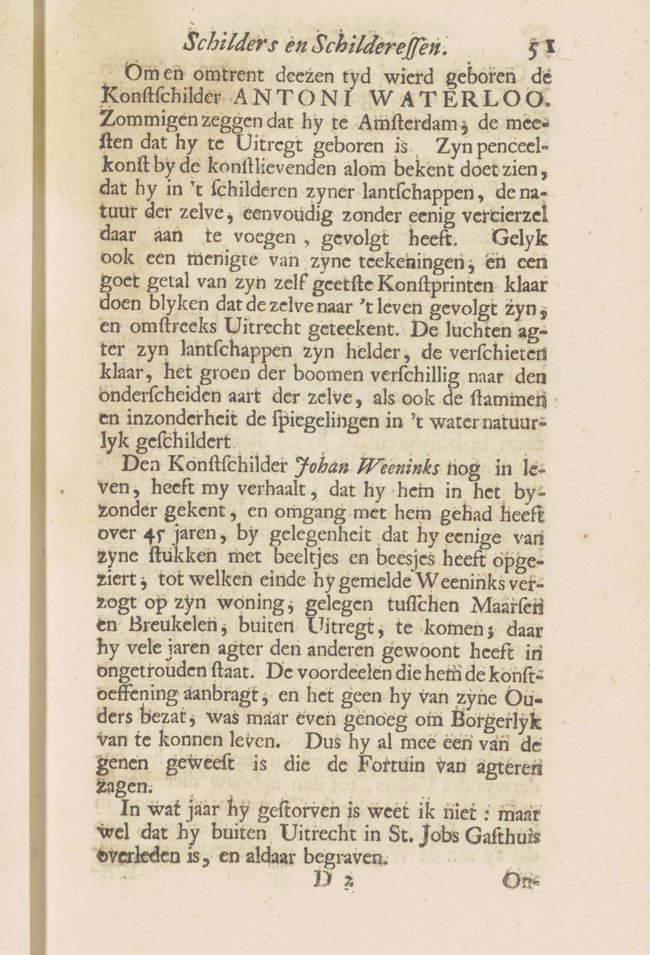
Page 52
Among his contemporaries and fellow artists there was one N. Kraanevelt about whom Joost van den Vondel composed the following epitaph.
Here rests Kraanevelt, whose favour,
Blazed, out of desire for the art of painting,
Who kept his hand commendablely and nobly
On his lively brush,
Honours the spirit in the artful work.
Keep a heron [Veltkraan] on the gravestone
JAN PHILIP van THIELEN, Lord of Kouwenberch, etc. was born in Mechlin in the year 1681 [= 1618]. His brush inclined to depicting everything that Flora contributes to the delight of gardens, and it could satisfactorily be deduced from his handling that he had taken over from Daniël Seghers the thin and delicate handling that is especially essential for flower painting. Indeed, his way of handling and sound arrangements were able to charm the Spanish court, for which he painted many flower pieces, by which his name and art have become famous. But what further consolidated his fame was that he had three daughters, Maria Theresia van Thielen, Anna van Thielen and Francisca Catharina van Thielen, who were paintresses, made a name for themselves and demonstrated that their innate nature, as much as or more than the instruction from their father, contributed to the formation of their art practice. They were still alive in 1660, and painted daily with zest and diligence, so that they gave great expectations to the world.

Page 53
CAREL van SAVOYEN was born in Antwerp in the year 1619. He painted mostly small figures in such detail and so naturally that Cornelis de Bie counts him among the flower of Brabant painters.
Among the poems of Jan Vos I find mention of one of his art works (depicting Adonis stolen away by Venus from Diana) in the room of Mister Willem Blaeu II.
Diana is robbed of Adonis, in the guise of BLAEU:
For Venus, full of deceit, does not spare sleeping eyes.
Awake, goddess of the hunt, before a greater disaster approaches.
Carefree sleep is easily cheated.
PHILIPS KONINCK , who was born in Amsterdam on the 5th of November of the year 1619, studied art with the famous Rembrandt van Rijn.
Joost van den Vondel, who was repeatedly portrayed after life by Koninck [2], composed this verse on his own portrait.
Thus I was painted by the hand of a Koninck [= king]
On small scale, while the Koninck’s strings
And holy harp song, and manner
I steadily follow, at the top of life’s years,
One less than seventy. What is it?
Even less than paint, a fog, a mist.
So also Jan Vos on the same portrait:
Now Koninck paints Vondel, the king of poets.
He is also a king in the capturing of his portrait.
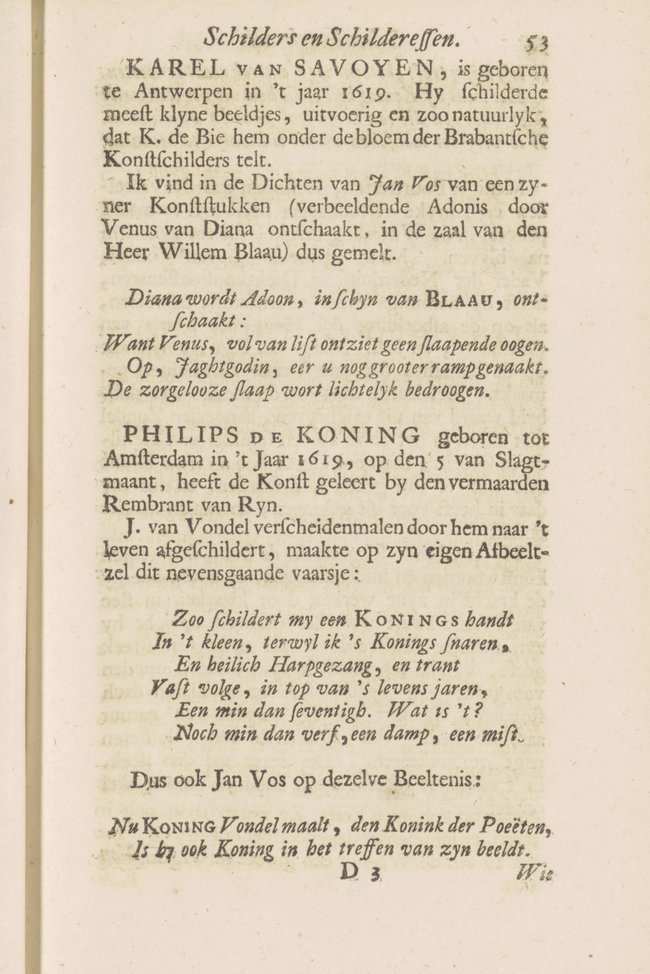

2
Philips Koninck
Portrait of Joost van den Vondel (1587-1679), 1650s
Amsterdam, Ons' Lieve Heer op Solder, inv./cat.nr. Br. 20
Page 54
He who captures life, shows fully to understand the outlines.
How does he reward Koninck best, who creates him from paints?
With verses which surpass a crown of pearls.
One who turns paint into people can hardly be repaid.
His famous brush brought into the world a multitude of portraits and histories worthy of ennoblement which remain behind to his fame. The more oft-mentioned Joost van den Vondel, father of the Dutch practitioners of poetry, has composed eulogies on some of his most important scenes, as on the depiction of the most noble Maria van Outshoorn and Miss Margaretha van Rijn as well the famous sleeping Venus. The latter seemed well worth discussing, seeing that Vondel does not only speak in it about painting like a painter, but also says everything about KONINCK’s art that is to be said and has thus gone before me, relieving me of that task.
He praises the beautiful in art through his own artistic vocabulary and expressions, and shows how he achieved the power of his works through clarity instead of nasty black, in which respect he takes a side swipe at his master Rembrandt, who, although his figures in the foreground of his scenes stood in full daylight, did not hesitate (against nature) to have the sky in the background enveloped in dark night. The reader will discover the jab in the following poem on the sleeping Venus.
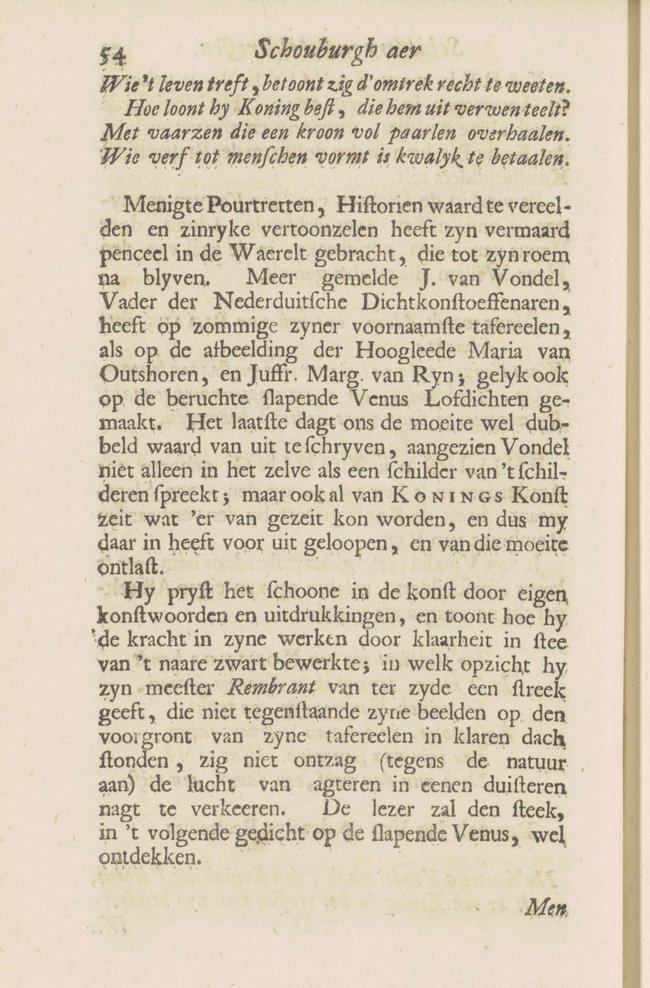
Page 55
When desire and art still ran together on the course,
People applied light and shadow on canvas and panel.
The one sets off the other. The shadows deepen.
The light is accentuated by the dark. The one part
Requires the other. What's in front hits our eyes
Very strongly, and what's behind recedes from our sight.
The comparison of these two has great power.
The dwarf enlarges the giant, the hut a large edifice.
Thus the art of painting also bears sons of darkness,
Who prefer to live in the dark, like an owl,
He who follows life can do without invented shadows
And as a child of light, will not hide in any twilight.
He paints without shade and shadow. Thus KONINCK follows
Clear nature; And if people should ask where this appears?
Look on this heavenly work, the living representation
Of Venus, who sleeps here, and resembles neither painting
Nor paint, but flesh and blood. Jupiter descends,
Wild about the beauty of a perfect creature,
Not in his own guise, but as golden rain.
Did the bold brush of Zeuxis seduce the very birds,
Here the chief of the gods is deceived by paint.
Thus painting once reached its greatest heights.
He died in Amsterdam, when it was recorded in October 1669. His portrait, based on his own painting, is seen in Plate B 3.
At this time there lived in Alkmaar the painter ZACHARIAS PAULUSZ.
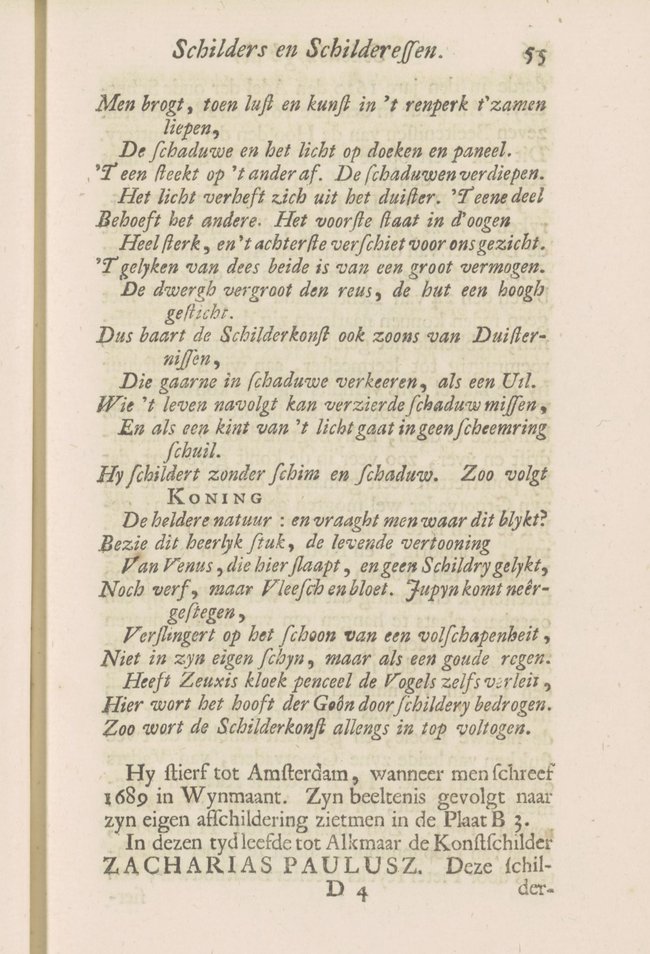
Page 56
In the year 1620 he painted the nobility of the old militia [3], as well as in the years 1627 to 1628 about seven portraits of the commanders of the militia [4]. This piece was placed in the old shooting range above the chimney of the captain’s chamber.
JACOB WILLEMSZ. DELFF II, son of the artful Willem Jacobsz. Delff, who was married to the daughter of Michiel van Mierevelt, the famous Apelles of that century and born as if straight out of art on the 24th of March of 1619. He could not be dissuaded from practicing it, having the luck of such a famous grandfather as teacher, at whose art fire he could daily light up his torch of art. And though no necessity spurred him on, not needing to do anything, he still progressed so far in art through his innate passion and diligence that he made portraits which may be compared with to those of his grandfather, as may be seen in Delft in the shooting range, where he painted captain, ensign and company commander of the white regimental ensign shown down to their feet so masterfully and artfully that it deserved to hang in a public place to be seen by lovers of art [5-6]. That is why, after the old shooting range collapsed on Monday the 12th of October, it was brought to the new range and placed between the two pieces by both his grandfathers, on his father’s and mother’s side. He was councilman and harbour master of the city and died on the 12th of May of 1661. In his memory, his widowed housewife, Anna van Hoogenhouck, had Pieter Ryckx, master sculptor, erect a
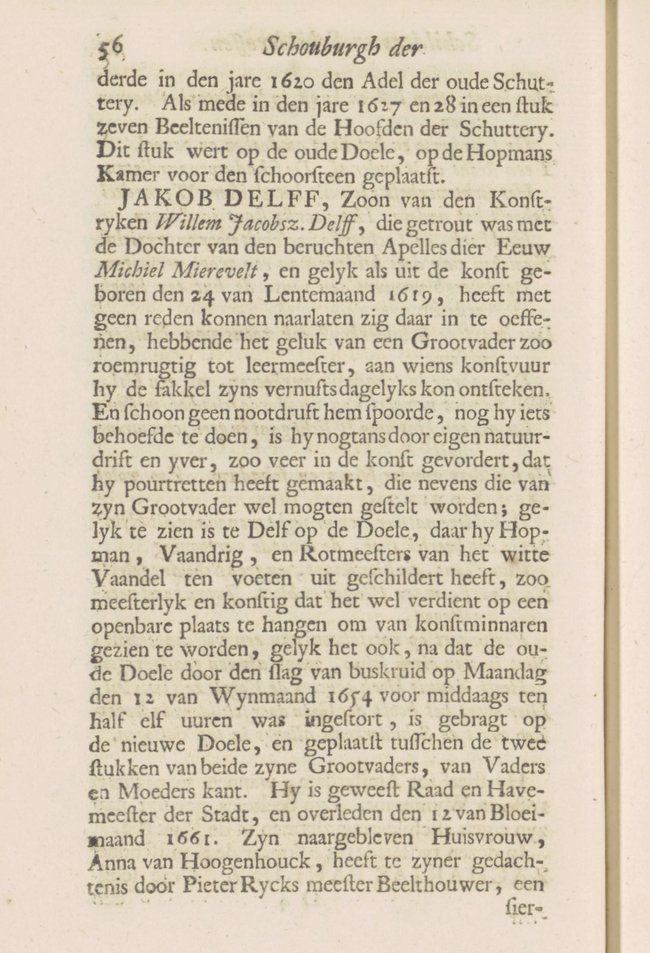

3
Zacharias Paulusz.
Militia piece of the the officers and standard-bearers of the Oude Schutterij, dated 1621
Alkmaar, Stedelijk Museum Alkmaar, inv./cat.nr. 21226

4
Zacharias Paulusz.
Militia piece of he officers and standard-bearers of the Old Gunnery, dated 1629
Alkmaar, Stedelijk Museum Alkmaar, inv./cat.nr. 21227

5
Michiel van Mierevelt
Maaltijd van de Delftse schutterij, dated 1611
Delft, Museum Prinsenhof Delft, inv./cat.nr. P.D.S. 67

6
Jacob Willemsz. Delff (II)
Officieren van het Witte Vendel, Delft, 1648, dated 1648
Delft, Museum Prinsenhof Delft, inv./cat.nr. PDS 24
Page 57
handsome sculpted stonework over his grave with this Latin inscription:
The most benevolent and exalted God
and
in pious remembrance of the most excellent man
Mister Jacob Delff,
Who served the office of council and harbour master
of the city of Delft with praise;
and on the 12th of June of the year 1661
at the true age of 42
has exchanged life for death,
expecting a blessed resurrection.
To her beloved spouse
Anna Hoogenhoeck Abraham's daughter,
has thus with sadness erected a monument.
I shall follow you most worthy spouse.
JAN BAPTIST van DEYNUM, born in Antwerp in the year 1620, painted artfully, wittily and elaborately in water colours small portraits and many other subjects which royal courts now still display. In 1651 he became captain of a civic band, but as this brought him much distraction and kept him from his practice, he resigned so as to invest all of his time in the service of the goddess of art.
Here also appears ADRIAEN VERDOEL I. Born on the other side of the Meuse, he had the great Rembrandt as his teacher of art, although others say Leonaerd Bramer and Jacob de Wet I, with whom he advanced so far in art that we
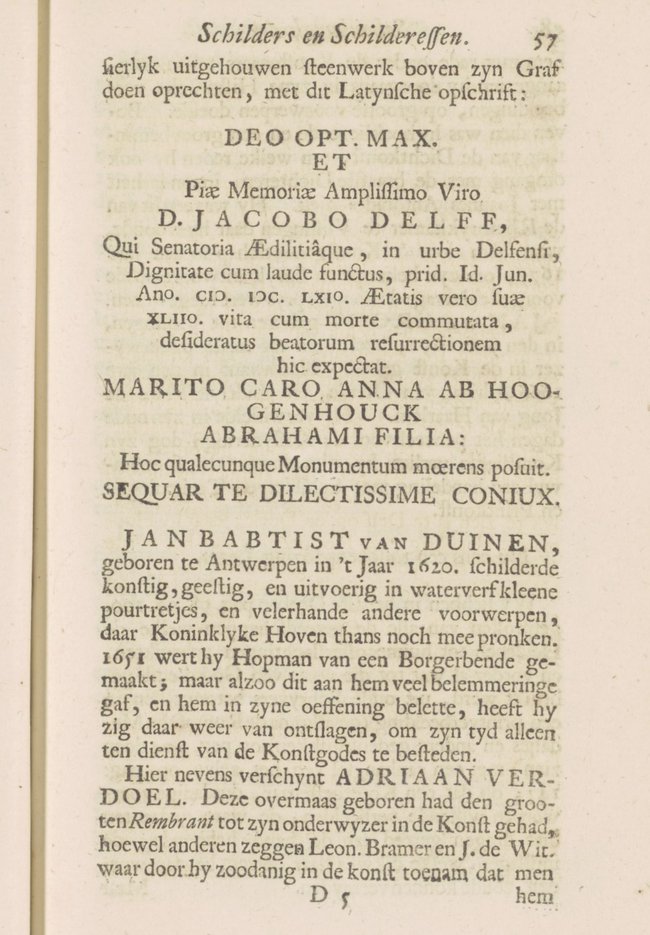
Page 58
may rightly include him with the artists, since he usually aimed at great subjects in his historical paintings. In addition he was a book lover and a great lover of poetry, for which reason he also associated with the most commendable poets, especially with Johannes Antonides van der Goes. He was a member of the chamber of rhetoricians in Vlissingen, where he lived and where in the year 1675 he won the highest price for his concise and meaningful answer to the proposed question.
JAN de GROOT, born in Vlissingen in the year 1650, had Adriaen Verdoel I as his first teacher of art. Later on, in the year 1666, followed Adriaen van Ostade and finally Frans de Jongh of Haarlem. In his old age he exchanged the brush for the coffee trade, but his love of art did not abandon him, for he sometimes traded in paintings, drawings and prints.
Now, for a change, an intermission, reader.
On pages 98, 99 and 100 of the first volume we spoke of all the equipment that the heathens used for their sacrificial slaughter and further everything that was used for that manner of religion as witnessed by ancient writers and shown on page 104 in a depiction in print (following Roman medals and other commemorative works), with an appendix concerning them on page 143, so that a practitioner of art wishing to depict such objects, having the true appearances of things readily at hand, would be able to avoid the mistakes often made concerning them.
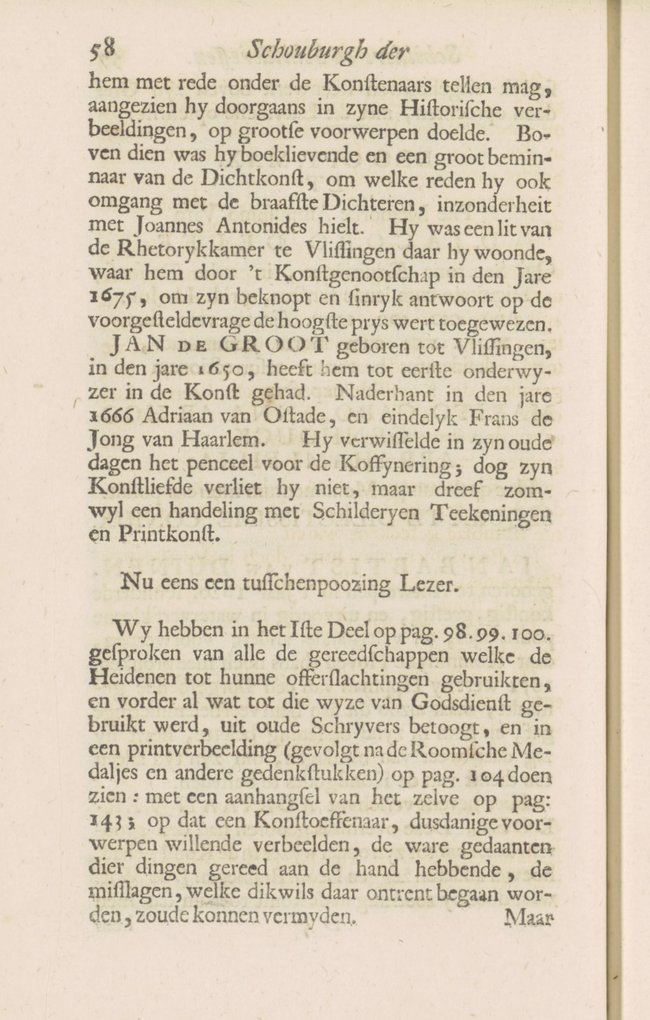
Page 59
But a painter may well want to display things of a more turbulent nature, such as a Roman commander presenting his oration in a crowd of soldiers, standing on a raised platform made of piled up sods in an open field, or a field commander being proclaimed emperor by the soldiers.
Such events were always accompanied by field banners and legionary standards which, along with other additions, will at once show the spectator of all such depictions (providing he has read a little or is competent in the study of antiquity) by the markings on the banners what incidents the painter has depicted. On this account we deemed it worth our while to research the standards of the peoples of ancient days and combine them in a list:
The Egyptians carried on their army banners three twisted snakes that were marked with an ivy leaf on every corner
The Babylonians a dove, but at the time of Samurais three great crowns in each of which stood an elephant.
The Syrians three beams of which the one was doubly multi-staged, the other single.
The Greeks two flat crowns (diadems) and a continuous beam with three descending steps, or else fire or lightning.
The Athenians the night-owl,* oxe or cow.
--------
* In addition to the night-owl being the impression of the Athenean coinage, one also sees it on a coin of Domitian, Anthony and Nero, and it is surmised that he had it minted to commemorate his Athenian journey. Seeing that an owl, or an oxe, was the common impression on Athenean money, from
